Michael J. Behe's Blog, page 171
August 10, 2021
At Mind Matters News: Randomness is not a scientific explanation
There is a general idea that everything new has its origins in randomness. This is because within our current philosophy of science, the two fundamental causes in our universe boil down to randomness and necessity. Since necessity never creates anything new, then by process of elimination the source of newness must be randomness. Similar to how the ancient Greeks believed the universe originated from chaos.
Here’s the irony of the view that whatever is unique in our universe is random: We can never know if anything is truly random. This is because randomness is unprovable, which was proven by three different computer scientists: Ray Solomonoff, Andrey Kolmogorov and Gregory Chaitin. The only thing we can know is that something is not random. Hence, we can never know that something originated from randomness.
News, “Randomness is not a scientific explanation” at Mind Matters News
Takehome: Three different computer scientists have proven that randomness is unprovable. The only thing we can know is that something is not random.
You may also wish to read: Computers are getting faster, but are they getting smarter? No. Computers are Turing machines, limited to operations that can be completely understood in relation to their programming. The Lovelace Test helps us understand the fundamental limits of computing as a method of thinking: It does not create new ideas. (Eric Holloway)
Copyright © 2021 Uncommon Descent . This Feed is for personal non-commercial use only. If you are not reading this material in your news aggregator, the site you are looking at is guilty of copyright infringement UNLESS EXPLICIT PERMISSION OTHERWISE HAS BEEN GIVEN. Please contact legal@uncommondescent.com so we can take legal action immediately.Plugin by Taragana
August 7, 2021
Researchers now believe skull found in 1933 belongs to “our closest relative” “species”
Move over, Neanderthal?
Despite being nearly perfectly preserved—with square eye sockets, thick brow ridges, and large teeth—nobody could work out exactly what it was. The skull is much bigger than that of Homo sapiens and other human species—and its brain size is similar to that of our own species. Historical events left it without a secure place of origin or date, until today.
Now a team of Chinese, Australian, and British researchers has finally solved the puzzle—the skull represents a previously unknown extinct human species. The research, published as three studies in the journal Innovation, suggests this is our closest relative in the human family tree.
Anthony Sinclair, “Is Homo longi an Extinct Human Species?” at Sapiens (August 4, 2021)
Homo longi is believed to have been fifty years old when he died 146,000 years ago.
But read on. There are problems with this interpretation:
The predicted dates for the common ancestors between human lineages do not match the dates of actual discovered fossils or those predicted by the analysis of DNA.
For example, this study proposes that Homo sapiens were in Eurasia at about 400,000 years ago. But the oldest fossil for this species known outside Africa is little more than half this age. At the same time, the split between Homo sapiens and Neanderthals predicted here at more than 1 million years old does not match the prediction of nuclear DNA analysis, which suggests it happened much later. However, it can be backed up by doing DNA analysis with genetic material taken from the cell’s engine, called the mitochondria.
The older estimates presented by this study may result from the use of new techniques, called Bayesian tip dating, which aren’t normally used in evolutionary studies.
Anthony Sinclair, “Is Homo longi an Extinct Human Species?” at Sapiens (August 4, 2021)
Sinclair adds that many of these “species” interbred.
In short, the claims may rest on a flimsy foundation.
See also: Human evolution at your fingertips
Copyright © 2021 Uncommon Descent . This Feed is for personal non-commercial use only. If you are not reading this material in your news aggregator, the site you are looking at is guilty of copyright infringement UNLESS EXPLICIT PERMISSION OTHERWISE HAS BEEN GIVEN. Please contact legal@uncommondescent.com so we can take legal action immediately.Plugin by Taragana
At The Atlantic: Cat genome looks and behaves “remarkably like ours”
At The Atlantic, Katherine J. Wu lets us in on a surprising genetic fact about mice and cats:
At some point in its evolutionary past, the mouse shuffled its ancestral genome like a deck of cards, futzing up the architecture that makes most other mammalian genomes look, well, mammalian. “I always consider it the greatest outlier,” Bill Murphy, a geneticist at Texas A&M University, told me. “It’s about as different from any other placental mammal genome as you can find, sort of like it’s the moon, compared to everything else being on the Earth.”
Katherine J. Wu, “One More Thing We Have in Common With Cats” at The Atlantic (July 28, 2021)
Mice are useful for research (easily bred and fungible) butt hey don;t tell us much about oour own genome. And cats?
Cats, it turns out, harbor genomes that look and behave remarkably like ours. “Other than primates, the cat-human comparison is one of the closest you can get,” with respect to genome organization, Leslie Lyons, an expert in cat genetics at the University of Missouri, told me.
Katherine J. Wu, “One More Thing We Have in Common With Cats” at The Atlantic (July 28, 2021)
Also, as so many cats live with people, they share many lifestyle disease issues with us.
But who would have thought that cats and humans would have such close genomes?
Some researchers now study them to learn more about human diseases. Fine, just so long as they don’t treat them the way they treat mice — or the way cats treat mice.
See also: In what ways are cats intelligent? Cats have nearly twice as many neurons as dogs and a bigger and more complex cerebral cortex.
Copyright © 2021 Uncommon Descent . This Feed is for personal non-commercial use only. If you are not reading this material in your news aggregator, the site you are looking at is guilty of copyright infringement UNLESS EXPLICIT PERMISSION OTHERWISE HAS BEEN GIVEN. Please contact legal@uncommondescent.com so we can take legal action immediately.Plugin by Taragana
FYI/FTR: What is “Monism”?
This is just a note for record on what monism is (as opposed to dualism, Creation by a Supreme and maximally great and good being, etc). A useful point of departure is a diagram from Wikipedia on dualism (and they give only one type) vs monism:
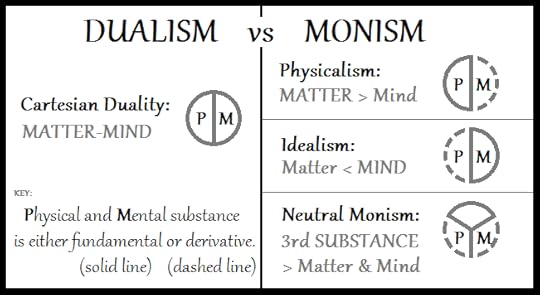
Wikipedia notes, next to this:
Different types of monism include:[12][18]
Substance monism, “the view that the apparent plurality of substances is due to different states or appearances of a single substance”[12]
Attributive monism, “the view that whatever the number of substances, they are of a single ultimate kind”[12]
Partial monism, “within a given realm of being (however many there may be) there is only one substance”[12]
Existence monism, “the view that there is only one concrete object token (The One, “Τὸ Ἕν” or the Monad)”[19]
Priority monism, “the whole is prior to its parts” or “the world has parts, but the parts are dependent fragments of an integrated whole”[18]
Property monism, “the view that all properties are of a single type (e.g., only physical properties exist)”
Genus monism, “the doctrine that there is a highest category; e.g., being”[18]
Views contrasting with monism are:
Metaphysical dualism, which asserts that there are two ultimately irreconcilable substances or realities such as Good and Evil, for example, Manichaeism.[1]
Metaphysical pluralism, which asserts three or more fundamental substances or realities.[1]
Metaphysical nihilism, negates any of the above categories (substances, properties, concrete objects, etc.).
Monism in modern philosophy of mind can be divided into three broad categories:
Idealist, mentalistic monism, which holds that only mind or spirit exists. [1]
Neutral monism, which holds that one sort of thing fundamentally exists,[20] to which both the mental and the physical can be reduced[8]
Material monism (also called Physicalism and materialism), which holds that the material world is primary, and consciousness arises through the interaction with the material world[21][20]
Certain positions do not fit easily into the above categories, such as functionalism, anomalous monism, and reflexive monism. Moreover, they do not define the meaning of “real”.
That’s just to begin to grasp vocabulary. SEP gives an interesting exchange, if you are interested:
There are many monisms. What they share is that they attribute oneness. Where they differ is in what they attribute oneness to (the target), and how they count (the unit). So strictly speaking there is only monismrelative to a target and unit, where monism for target t counted by unit u is the view that t counted by u is one.
Monisms are correlative with pluralisms and nihilisms. Where the monist for target t counted by unit u holds that t counted by u is one, her pluralist counterpart holds that t counted by u is many, and her nihilist counterpart holds that t counted by u is none. Among pluralists it is sometimes useful to single out the dualist: the dualist for t and u holds that t counted by u is two
To illustrate these various doctrines for various targets and units, let the target t1= concrete objects, and let the unit u1= highest type. To be a monist for t1 counted by u1 is to hold that concrete objects fall under one highest type. The materialist, idealist, and neutral monist are all monists of this sort (substance monism). They all agree that concrete objects fall under one highest type, disagreeing only over whether the one highest type is material, mental, or something deeper.
To be a pluralist for t1 counted by u1 is to hold that concrete objects fall under more than one highest type. The Cartesian dualist is a pluralist of this sort (substance dualism). She holds that concrete objects fall under two highest types: the material (with the primary attribute of extension), and the mental (with the primary attribute of thought).
To be a nihilist for t1 counted by u1 is to hold that concrete objects fall under no highest type. The bundle theorist who is an eliminativist about concrete objects is a nihilist of this sort (substance nihilism). She rejects the target: she thinks that there are no concrete objects to count.[1] One who accepts concrete objects but rejects the relevant notion of “highest” type would also be a nihilist for t1 counted by u1. She rejects the unit: she thinks that this is no way to count . . .
The relevant context is the challenge since Thales of Miletus to account for unity and diversity in a coherent domain, reality, with room for responsible, rational, morally governed contingent creatures such as we are; on pain of collapse of credibility of our very rationality to think about such. Such self-defeat is a sign that a view is absurd. The general challenge, in short is that of the one and the many.
For record, I have argued for cause that, in describing core substances, materialist or physicalist monisms end in trying to account for the mind on a computational substrate. This ends in undermining rational freedom, putting in its place GIGO limited processing that is dynamic-stochastic.
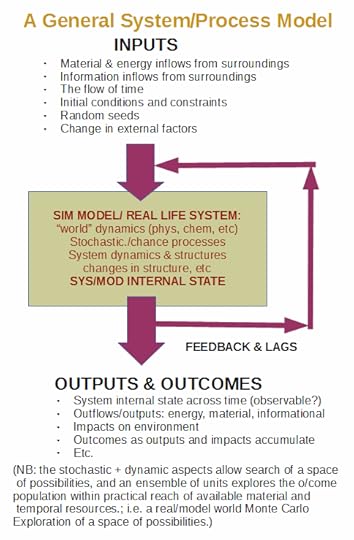
For example, here is an adder circuit element for a computer ALU:

This is a key element for addition, exploiting how electronic circuits can implement boolean algebra thus the logic of bitwise addition.
Extending to a digital computer:

Extending into a Tanenbaum style stack model:
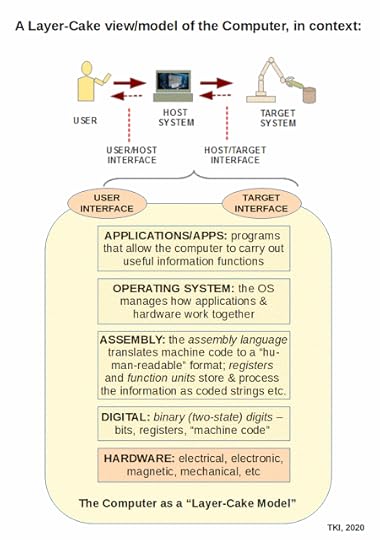
In short, a sophisticated electronic machine but not a free responsible, rational agent.
If you want to go analogue, here is a simple case, the sight for a classic 0.303 calibre SMLE Mk III:

Here, the curved ramp programs for bullet drop at various ranges, allowing for reasonably accurate fire. Again, a dynamic-stochastic system, not a rational free agent.
A neural network:
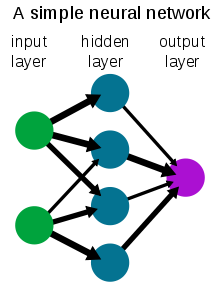 Simplified model of a neural network
Simplified model of a neural networkHere, cumulative weighted inputs trigger firing of neurons at nodes. Clever, but again a dynamic-stochastic system.
This is to remind us of Leibniz in his analogy of the mill:
It must be confessed, however, that perception, and that which depends upon it, are inexplicable by mechanical causes, that is to say, by figures and motions. Supposing that there were a machine whose structure produced thought, sensation, and perception, we could conceive of it as increased in size with the same proportions until one was able to enter into its interior, as he would into a mill. Now, on going into it he would find only pieces working upon one another, but never would he find anything to explain perception [i.e. abstract conception]. It is accordingly in the simple substance [–> the inherently unified monad], and not in the compound [–> composite made up from independently existing parts] nor in a machine [–> composite entity with function based on mechanical and/or stochastic interactions not insight, understanding, conceptualising, inferring based on meaning etc] that the perception is to be sought
Materialistic monism, reduction to matter, fails.
Mental type monisms, equally for cause, turn our first fact of conscious experience, embodiment and participation in a common world as living bodies, into a Plato’s cave type shadow show, a grand delusion. (I have suggested a thought test: cease breathing for an hour, in a dreamscape or vision or simulation, no consequences of significance; in waking reality, fatal consequences . . . this is strictly a don’t try this at home thought exercise. I recall a short Sci Fi novel where children raised in a simulation world identified base waking reality by the permanence of death there.)
I remember, to note.
In a simulation world by a super-intellect or hyper-computer, there are no experiences for the characters. If we try a network of nodes that each run sims of some sort, and are somehow self aware projecting embodiment in a world, such is clearly a network of Plato’s cave delusions, leading to the level two challenge. That is, the level two world of alleged self awareness of being a node may instead only be the next cave and so forth.
There is no good reason to doubt that our first facts of conscious reality are false. If we insist on the doubt, that leads to a regress of similar invited doubts at every successive level and one so enmeshed has no reason to take his or her rationality as perceived as credible. Think about extending this endlessly:
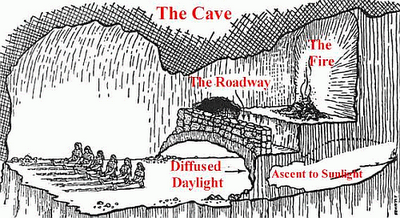
Or, we may ponder:
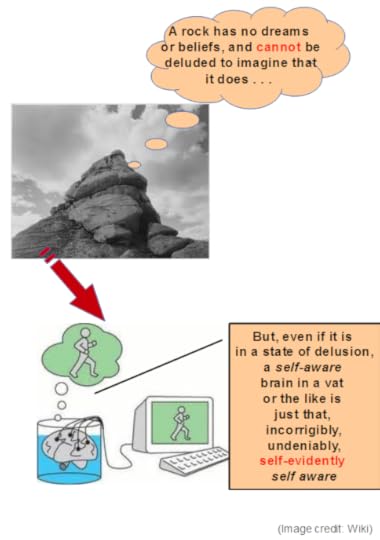
Would you buy a used car from a Cave-prisoner, or a brain in a vat?
While we’re at it let’s use the Smith model as a way to discuss a two-tier controller cybernetic loop that can model embodiment:
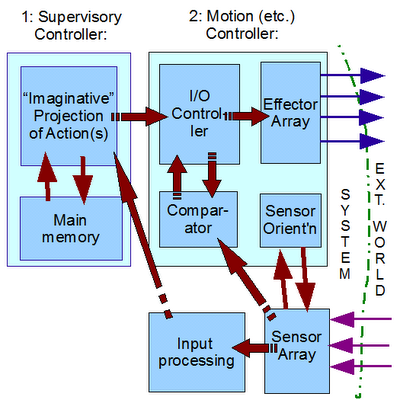 The Eng Derek Smith Cybernetic Model
The Eng Derek Smith Cybernetic ModelOf course, that does not mean that we do not err. We do, but there is no good reason to entertain wild hyperskeptical doubts that end in self-referential discredit of rationality.
It remains, that our worldviews face a need to address the challenge of the one and the many. Not easy, but it has been responsibly done.
This being a FYI that has room for illustrations, this will not further stretch out the threads taken up with such debates. The latest sidetracked thread is enough. END
Copyright © 2021 Uncommon Descent . This Feed is for personal non-commercial use only. If you are not reading this material in your news aggregator, the site you are looking at is guilty of copyright infringement UNLESS EXPLICIT PERMISSION OTHERWISE HAS BEEN GIVEN. Please contact legal@uncommondescent.com so we can take legal action immediately.Plugin by Taragana
Talk about convergent evolution: Lizards evolved for life in trees at least 100 times
After studying 2600 species:
Sticky toepads have independently evolved in geckos, skinks and Anolis lizards — producing tree acrobats specially adapted to life in the forest canopy. Scientists have long considered sticky toepads an ‘evolutionary key innovation’ that allow arboreal lizards to interact with the environment in ways that many padless lizards cannot. Yet, some lizards without toepads have adopted the canopy lifestyle, an observation that has puzzled scientists for decades. Biologists Aryeh Miller and James Stroud at Washington University in St. Louis set out to find if lizards with toepads had an evolutionary advantage for life in the trees relative to their padless counterparts. They analyzed data from 2,600 lizard species worldwide and discovered that, while hundreds of different types of lizards have independently evolved arboreal lifestyles, species that possessed sticky toepads prevailed.
Washington University in St. Louis, “Sticky toes unlock life in the trees” at ScienceDaily (August 5, 2021)
Now here is where it gets interesting:
Miller, who led the analysis, is the first to find that species have evolved for specialized life in trees at least 100 times in thousands of lizards. In other words, it is evolutionarily easy for a lizard to become a tree lizard.
What’s difficult is sticking around (pun intended!). Toepads don’t evolve until after lizards get into the trees, not before. And padless lizards will leave trees at a high frequency — much higher than padbearing lizards.
“There are hundreds of lizards living in the trees, but over evolutionary time many of those species end up leaving for life on the ground because, presumably, they interact with these padded lizards that have a greater advantage,” Stroud said.
Washington University in St. Louis, “Sticky toes unlock life in the trees” at ScienceDaily (August 5, 2021)
Okay, now here’s a question: How, exactly, does the tree lizard “evolve” toe pads just because they would be convenient? It’s not self-evident. Many lizards did not but others did. As Michael Behe would ask, “How, exactly?”
Convergent evolution is often portrayed as a friend to Darwinism but it really isn’t. Not when we look closely at what is being said. No “how exactly.” “Natural selection” is often treated as a magic concept and we aren’t supposed to notice that.
The paper is closed access.
See also: Evolution appears to converge on goals—but in Darwinian terms, is that possible?
Copyright © 2021 Uncommon Descent . This Feed is for personal non-commercial use only. If you are not reading this material in your news aggregator, the site you are looking at is guilty of copyright infringement UNLESS EXPLICIT PERMISSION OTHERWISE HAS BEEN GIVEN. Please contact legal@uncommondescent.com so we can take legal action immediately.Plugin by Taragana
August 6, 2021
At Mind Matters News: How philosopher John Locke turned reality into theatre
His “little theater in the mind” concept means that you can’t even know that nature exists. It may just be a movie that’s being played in front of your eyes
Michael Egnor: Sure. It’s a classic debate in philosophy of mind. It goes back really to John Locke: What does perception mean?
Locke argued that what we experience in our minds is our perceptions. And perceptions are essentially pictures of the outside world, that are projected onto our brain in some form.
[Philosopher Daniel] Dennett has called this the “Cartesian theater.” It’s as if there’s a little “us” sitting inside our brains in a little theater, and our eyes are shining movies, and our ears are shining audio, and everything’s coming into this theater …
I think Locke made a terrible mistake. The problem with that way of looking at things is that a completely cuts you off from reality. (00:48:11)
News, “How philosopher John Locke turned reality into theatre” at Mind Matters News
Takehome: Aristotle and Aquinas’s traditional philosophical approach, Michael Egnor argues, offers more assurance that we can truly perceive reality.
Here’s a transcript and notes for the first 47 minutes:
How did Descartes come to make such a mess of dualism? Mathematician René Descartes strictly separated mind and matter in a way that left the mind very vulnerable. After Descartes started the idea that only minds have experiences, materialist philosophers dispensed with mind, then puzzled over how matter has experiences.
What’s the best option for understanding the mind and the brain? Theories that attempt to show that the mind does not really exist clearly don’t work and never did. Neurosurgeon Michael Egnor reviews the mind-brain theories for East Meets West: Theology Unleashed. He think dualism makes the best sense of the evidence.
How we can know mental states are real?
Mental states are always “about” something; physical states are not “about” anything. Michael Egnor argues that doing science as a physicalist (a materialist) is like driving a car with the parking brake on; it’s a major impediment to science.
Why neurosurgeon Mike Egnor stopped being a materialist atheist. He found that materialism is just not working out in science. Most propositions in basic science are based on mathematics and mathematics is not a material thing.
and
How science points to meaning in life. The earliest philosopher of science, Aristotle, pioneered a way of understanding it. Neurosurgeon Michael Egnor talks about the four causes of the events in our world, from the material to the mind.
You may also wish to read: Why the universe itself can’t be the most fundamental thing. Atheist biology professor Jerry Coyne is mistaken in dismissing my observation that proofs of God’s existence follow the same logical structure as any other scientific theory. (Michael Egnor)
Copyright © 2021 Uncommon Descent . This Feed is for personal non-commercial use only. If you are not reading this material in your news aggregator, the site you are looking at is guilty of copyright infringement UNLESS EXPLICIT PERMISSION OTHERWISE HAS BEEN GIVEN. Please contact legal@uncommondescent.com so we can take legal action immediately.Plugin by Taragana
Eleven different varieties of spiders feed on snakes
We didn’t know that any did:
Take the Australian redback. Not including legs, a female of this species of spider is only about the size of an M&M candy. But she can take down relatively big prey such as juvenile eastern brown snakes, which are among the most venomous serpents in the world. A snake that gets trapped in a redback’s web — a messy tangle of long, sticky silk threads that dangle to the ground — is quickly set upon by the spider, which subdues the struggling victim with more sticky silk before delivering a toxic bite that eventually kills the snake…
“I didn’t realize how common this was. I don’t think anybody did,” says evolutionary biologist Mercedes Burns of the University of Maryland, Baltimore County, who was not involved in the research.
Asher Jones, “Snake-eating spiders are surprisingly common” at ScienceNews (August 4, 2021)
Some types of spiders can catch snakes 10 to 30 times their size. It is a hidden system of venomous snake control.
The paper is open access.
Hey, slow news day.
Copyright © 2021 Uncommon Descent . This Feed is for personal non-commercial use only. If you are not reading this material in your news aggregator, the site you are looking at is guilty of copyright infringement UNLESS EXPLICIT PERMISSION OTHERWISE HAS BEEN GIVEN. Please contact legal@uncommondescent.com so we can take legal action immediately.Plugin by Taragana
The 3n + 1/ n/2 conjecture
Here is an example of how numbers can give us hard puzzles:
The obvious point, for the naturals is that 3n + 1 converts an odd to an even and division by two pulls out an odd factor or else gets into the chain of powers of two, which has precisely one odd member, 1.
Where, of course, conveniently, 3 * 1 + 1 is 4. Thus the halting loop. (The negatives bring in other loops on their side of zero.)
So, the [pseudo-?]algorithm — does it always halt? — is searching for the ladder of powers of 2. Find it and you halt, fail and you explode into a halting fail. Or, is there another loop in the positive integers? Or, what?
What this reminds us, is how structured numbers are and how challenging stepwise procedures on numbers are. That points to issues with computationalism on a blindly programmed and organised substrate as dominant narrative of the mind.
Ponder the alternative: the mind is an oracle. As in:
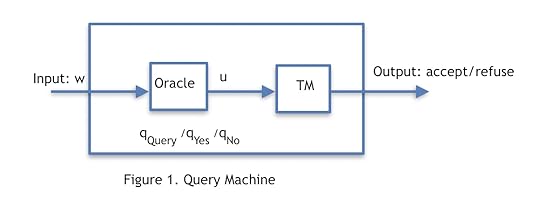
This shifts the framework of a Turing Machine. Wikipedia summarises:
An oracle machine can be conceived as a Turing machine connected to an oracle. The oracle, in this context, is an entity capable of solving some problem, which for example may be a decision problem or a function problem. The problem does not have to be computable; the oracle is not assumed to be a Turing machine or computer program. The oracle is simply a “black box” that is able to produce a solution for any instance of a given computational problem:
A decision problem is represented as a set A of natural numbers (or strings). An instance of the problem is an arbitrary natural number (or string). The solution to the instance is “YES” if the number (string) is in the set, and “NO” otherwise.
A function problem is represented by a function f from natural numbers (or strings) to natural numbers (or strings). An instance of the problem is an input x for f. The solution is the value f(x).
An oracle machine can perform all of the usual operations of a Turing machine, and can also query the oracle to obtain a solution to any instance of the computational problem for that oracle. For example, if the problem is a decision problem for a set A of natural numbers, the oracle machine supplies the oracle with a natural number, and the oracle responds with “yes” or “no” stating whether that number is an element of A.
As numbers can code for anything [think, Binary codes], this is broadly applicable.
Oracles can know [intuitively?], can guess, can learn, can obviously err, but they decide in effectively one step once they find themselves ready. They can of course also refuse or hesitate, leading to defaulting behaviours that may be grossly sub optimal.
So, let us again look at the Smith cybernetic loop model of embodied self-direction with freedom, from that perspective, with the supervisor being an oracle:
 The Eng Derek Smith Cybernetic Model
The Eng Derek Smith Cybernetic ModelFood for thought. END
Copyright © 2021 Uncommon Descent . This Feed is for personal non-commercial use only. If you are not reading this material in your news aggregator, the site you are looking at is guilty of copyright infringement UNLESS EXPLICIT PERMISSION OTHERWISE HAS BEEN GIVEN. Please contact legal@uncommondescent.com so we can take legal action immediately.Plugin by Taragana
August 5, 2021
Did longer days on early Earth set the stage for complex life?
Day lengths on Earth have varied a great deal. As per fine-tuning of Earth for life, the Moon is responsible for slowing Earth’s rotation down.
Researchers already knew, from modeling the Moon’s distance from Earth and the resulting atmospheric and oceanic tides, that the infant Earth turned much faster on its axis than it does today. Many agree that 4.5 billion years ago, a day was only about 6 hours long. By about 2.4 billion years ago, the models predict, the pull of the Moon had slowed that spin to about a 21-hour day. Earth’s rotational speed then stayed constant for about a billion years, as its gravitational pull countered the Moon’s drag. Those forces fell out of balance about 700 million years ago, because the resonance cycle between Earth and the Moon is not completely stable, and the planet’s spin slowed to its current speed, creating a 24-hour day, according to the models
Elizabeth Pennisi, “‘Totally new’ idea suggests longer days on early Earth set stage for complex life” at Science (August 2, 2021)
The longer day lengths were consistent with leaps in atmospheric oxygen, thought to help promote complex life.
Others counter:
Still, Lyons and others say, many factors likely contributed to the rise in oxygen. For example, Fischer suspects free-floating cyanobacteria, not just those in rock-affixed mats, were big players. Benjamin Mills, an Earth system modeler at the University of Leeds, thinks the release of oxygen-binding minerals by ancient volcanoes likely countered the early buildup of the gas at times and should be factored into oxygen calculations.
Elizabeth Pennisi, “‘Totally new’ idea suggests longer days on early Earth set stage for complex life” at Science (August 2, 2021)
The paper is open access.
Of course, there is much more to complex life than just having oxygen but length of days is surely worth pursuing.
See also: What becomes of science when the evidence does not matter?
Copyright © 2021 Uncommon Descent . This Feed is for personal non-commercial use only. If you are not reading this material in your news aggregator, the site you are looking at is guilty of copyright infringement UNLESS EXPLICIT PERMISSION OTHERWISE HAS BEEN GIVEN. Please contact legal@uncommondescent.com so we can take legal action immediately.Plugin by Taragana
August 4, 2021
Why is an elaborate system for keeping populations in check supposed to be “evolutionary chaos”?
The caterpillar-wasp-virus predation system is complex but there is no reason to think it is chaos:
One of the groups involved is the Lepidoptera, the butterflies and moths. They are seemingly the victims in this story because, like any other species, they can be infected by viruses. Many of these viral infections can be fatal, although some kill the animal quickly, and others take their time. Since they often strike during the larval/caterpillar stages, the viruses need other hosts to transfer the viruses to other victims.
Some of the species that perform this transport service are parasitic wasps, which have their own designs on the butterflies. The wasps lay eggs on caterpillars, and the larvae that emerge simply start eating the caterpillar while it’s still alive.
This situation sets up some complicated competitions. For example, some viruses may depend on the wasp to spread to new hosts but, once there, start competing with the wasps for the cells of the hapless caterpillar. The caterpillars are not entirely defenseless, though, and some are able to mount an immune response to the virus. Some strains also appear to be able to resist the invasion by wasp larvae. However, viruses often encode proteins that tamp down on the immune response to their benefit, which would also benefit their competition for cells.
John Timmer, “Evolutionary chaos as butterflies, wasps, and viruses have a three-way war” at Ars Technica July 30, 2021
It’s just more complex than humans might have expected it to be and perhaps more complex than we could design.
The paper is closed access.
Copyright © 2021 Uncommon Descent . This Feed is for personal non-commercial use only. If you are not reading this material in your news aggregator, the site you are looking at is guilty of copyright infringement UNLESS EXPLICIT PERMISSION OTHERWISE HAS BEEN GIVEN. Please contact legal@uncommondescent.com so we can take legal action immediately.Plugin by Taragana
Michael J. Behe's Blog
- Michael J. Behe's profile
- 219 followers



